| 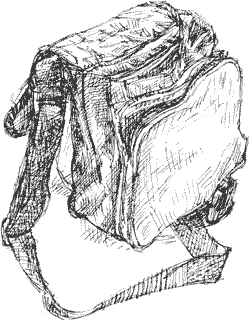 'I'd love to know what you use (pen/pencil types, etc.) to create your
drawings' writes Joy Rothke. Joy is an American freelance
writer who also loves to draw and she's based in Costa Rica. Surprising
who you meet on the internet, isn't it?
'I'd love to know what you use (pen/pencil types, etc.) to create your
drawings' writes Joy Rothke. Joy is an American freelance
writer who also loves to draw and she's based in Costa Rica. Surprising
who you meet on the internet, isn't it?
I've referred to my favourite pens and watercolours in this diary over
the years but I thought this was a suitable opportunity to delve into
my art bag again and explain its contents.
'Butch Organizer'
This is my favourite art bag at the moment. Barbara spotted it in the
National Trust shop at Clumber Park when we took a coffee break there
on our journey to Norfolk last May. As it's in drab olive green with black
straps there's absolutely no danger of it being mistaken for a handbag.
Is there?
'If it comes up as 'handbag' when you enter it on the till I'm not buying
it!' I told the assistant when I took it to the counter.
'Let's see', she said as she scanned it, 'Ah, 'Butch Organizer',
that's £15 please.'
An A5 sketchbook fits neatly into the main compartment of this 'organizer
bag' (to give it its correct description), small pens fit in an upright
compartment at the back, larger pens in a horizontal pocket, my watercolour
tube (see below) in another smaller pocket and a pod of crayons
in the front. There's room for a small bottle of mineral water in the
main compartment too. And my cloth sun hat, reading glasses, headache
pills, band aids . . . all the stuff you'd normally carry in a handbag,
sorry, organizer'
I've even attached a compass and thermometer key fob to one of the zippers.
Art Pen
 The
drawing of the bag (above left) was made with my favourite pen,
which I've mentioned many times through this diary; a Rotring
Art Pen with an extra fine sketch nib. This is a fountain pen
which I keep loaded with black ink cartridges and I have another that
has a fountain pen filler in it, filled with sepia Manuscript
Calligraphy Writing Ink. For some reason the sepia doesn't flow
as well as the black (I've tried sepia cartridges too), I'm not sure whether
it's due to the ink or that particular pen. It's difficult to use with
watercolours as the ink runs when wet but that does mean you can do a
quick wash drawing by dabbing the pen line with a wet brush (as in last
Wednesday's diary page) The
drawing of the bag (above left) was made with my favourite pen,
which I've mentioned many times through this diary; a Rotring
Art Pen with an extra fine sketch nib. This is a fountain pen
which I keep loaded with black ink cartridges and I have another that
has a fountain pen filler in it, filled with sepia Manuscript
Calligraphy Writing Ink. For some reason the sepia doesn't flow
as well as the black (I've tried sepia cartridges too), I'm not sure whether
it's due to the ink or that particular pen. It's difficult to use with
watercolours as the ink runs when wet but that does mean you can do a
quick wash drawing by dabbing the pen line with a wet brush (as in last
Wednesday's diary page)
 Parallel
Pen Parallel
Pen
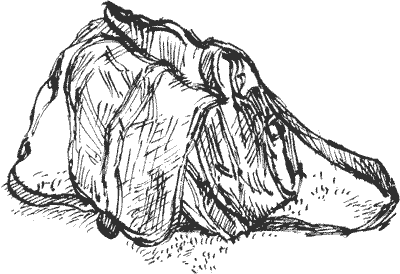 Another
drawing of the bag, made with another pen, the Pentel Parallel
Pen. The chisel-shaped nib is made of two parallel plates of
metal and is designed so that you can use the broad side or the narrow
edge. Another
drawing of the bag, made with another pen, the Pentel Parallel
Pen. The chisel-shaped nib is made of two parallel plates of
metal and is designed so that you can use the broad side or the narrow
edge.
The non-waterproof ink is available in black and red cartridges. The
pen is intended for calligraphy and I find it a bit awkward to draw with
but I like the finished effect, which is similar to what you'd get with
a bamboo or reed pen, so it's worth the effort from time to time.
Fibre Tipped Pens
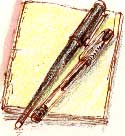 
I've tried numerous fibre tipped pens including the Staedtler
Pigment Liner, which I'm currently carrying with me in a 0.5
and 0.3 nib. They're waterproof and reliable but I prefer the Edding
1800 (the blue pen, above right) because it is available
in sepia, a useful colour for my natural history work, and it's waterproof
so it works well with a watercolour wash over the drawing.
Brush Pens
 This
Pentel Brush Pen has been a favourite for years. When
I feel I've got too fiddly with my drawing (which is most of the time,
if I was being honest) this pen forces me to simplify the drawing and
encourages me to work faster. This
Pentel Brush Pen has been a favourite for years. When
I feel I've got too fiddly with my drawing (which is most of the time,
if I was being honest) this pen forces me to simplify the drawing and
encourages me to work faster.
 I
haven't used the Pentel Color Brush, (right) a
similar product which is available in sepia, much yet. I
haven't used the Pentel Color Brush, (right) a
similar product which is available in sepia, much yet.
Parker Pen
 Here's
a new addition to my art bag, a comfortable Parker Fountain Pen,
with a rubber grip that isn't too chunky. This is strictly for writing
with; the words just flow when I'm sitting with this. Here's
a new addition to my art bag, a comfortable Parker Fountain Pen,
with a rubber grip that isn't too chunky. This is strictly for writing
with; the words just flow when I'm sitting with this.
Of course, being me, the 'strictly for writing' bit soon got ignored
and I've enjoyed drawing with it too. I keep it filled with blue ink.
Disadvantage: it takes only Parker cartridges.
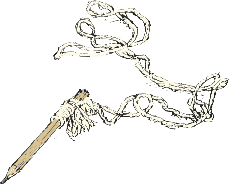 Pencils Pencils
At the moment I happen to have an HB, a B
and two 4Bs in the bag but it's very rarely that I use
them in my sketchbooks. During the summer I made a start with Drawing
on the Right Side of the Brain by Betty Edwards
and, as she suggests drawing with a 4B, something I'd
never tried before, I decided to give it a go. As I'm doing the exercises
here at home I work on individual sheets of A4 cartridge and keep them
in a file envelope.
However, for sketchbook work, I don't think I'll ever move onto pencil;
with the rough treatment my sketchbooks get the pencil soon gets smudged.
The old pencil on a string was something I wore around my neck when I
was revising Village Walks in West Yorkshire last autumn and
winter. There's an advantage of pencil: it's waterproof.
Crayons
 This
useful selection of Derwent Watercolour Crayons comes
in a plastic pod. Although you can get a watercolour effect by brushing
a watercolour crayon drawing with water, I invariably use them dry, as
a quick way of colouring a drawing. Being in a pod I can get them out
of the front pocket of my bag even in a confined space, such as at a café
table or on a train. This
useful selection of Derwent Watercolour Crayons comes
in a plastic pod. Although you can get a watercolour effect by brushing
a watercolour crayon drawing with water, I invariably use them dry, as
a quick way of colouring a drawing. Being in a pod I can get them out
of the front pocket of my bag even in a confined space, such as at a café
table or on a train.
Disadvantage: the plastic lid wasn't up to the
rough conditions in my bag and the fastening has broken. I'm now
looking for a suitable tin.
Solution: Just realised; the crayons fit neatly
into the tin that comes with a Rotring Art Pen. |
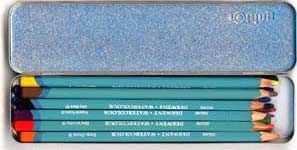 |
Watercolours |
|
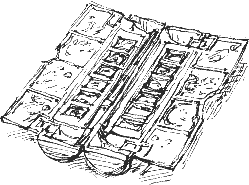 |

This Daler Rowney box of Artist's Watercolours
folds into a 6½ inch long tube. I've slightly altered the
range of colours that comes with it, as I recently explained in
a page about working with colour blindness.
I keep a cut down old brush in the box just so I've got one with
me. I haven't come up with a way of fitting my best sable brushes
into the bag.

|
|
Water
  This
might seem like stating the obvious but don't forget to take some water
for the watercolours. The small plastic bottle came from Boots
back in the 1970s when I broke a glass jar I used to carry with me. This
might seem like stating the obvious but don't forget to take some water
for the watercolours. The small plastic bottle came from Boots
back in the 1970s when I broke a glass jar I used to carry with me.
I've had this Water Brush, another Pentel
product, nearly a year now and I wouldn't be without it. You fill the
barrel with water, control the flow by squeezing it and clean the brush
with a piece of paper towel or tissue, or, if you're using it in a café,
as I frequently am, a paper serviette
Sketchbook
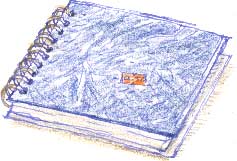 |
My current sketchbook is this 6
x 6 inch acid free cartridge with handmade cover from our local
sketchbook makers, The Pink Pig.  |
Related Links
Richard Bell, richard@willowisland.co.uk
|
![]()



![]()
![]() This
might seem like stating the obvious but don't forget to take some water
for the watercolours. The small plastic bottle came from Boots
back in the 1970s when I broke a glass jar I used to carry with me.
This
might seem like stating the obvious but don't forget to take some water
for the watercolours. The small plastic bottle came from Boots
back in the 1970s when I broke a glass jar I used to carry with me.